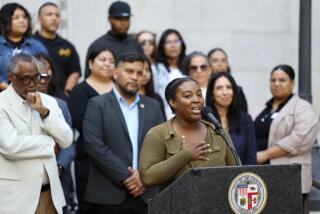A Door to Independence
- Share via
Etta Finney was desperate. Laid off from her clerk’s job at Northrop Grumman Corp. in El Segundo, the single mother of two frantically searched the Yellow Pages for a social service agency, a support group--anything--to help her keep a roof overhead and food on the table.
Manuel Cisneros was devastated. Looters destroyed his South-Central Los Angeles auto body shop during the 1992 riots. With no insurance to cover the loss and no income, he had little choice but to move his wife and four children into a public housing project in Long Beach.
Paul Jefferson was shaken. The 1994 Northridge earthquake left him without a job and unable to make the monthly rent on his Encino townhouse.
Together, their tales of woe personify Los Angeles’ travails that peaked in the 1990s with the confluence of the recession, the riots and a magnitude 6.7 earthquake.
Determined to get back to where they once had been, all three signed up for a little-known federal program that seeks to move poor families from welfare to work and homeownership within five years. None had needed public assistance before they were knocked off stride by circumstance, and all had been gainfully employed for years.
Since it began in 1993, the Family Self-Sufficiency program, which received $29 million in federal funding this fiscal year, has provided counseling, job training, home-buying seminars and escrow savings accounts to tens of thousands of low-income families nationwide.
Some 50,000 heads of households are enrolled in the program that is administered by the Department of Housing and Urban Development and operated by 1,200 local housing authorities across the country.
The city of Los Angeles launched the FSS program in 1995, its start date delayed a year by the earthquake. So far, 67 heads of households have graduated from the program and 3,140 low-income families are enrolled.
Los Angeles County also runs an FSS program, contracting with three nonprofit agencies to oversee it. Since 1994, some 40 heads of households have graduated and 900 families are enrolled.
“We are seeing the first graduates of the five-year program,” said Steve Renahan, director of the city housing authority’s Section 8 program, a federally funded effort to help low-income families find affordable housing. “Issuing escrow checks is beginning to become routine.” The checks, from participants’ escrow savings, average about $6,400.
Finney, laid off from her aerospace job in 1985, said the $2,500 escrow check she received after completing the program last June will be used as a down payment not only on a hom but also on a better future.
Couldn’t Get Ahead on Public Assistance
“You can’t do anything on public assistance,” said Finney, 44, of Paramount, referring to her years on welfare. “You are in their little clutches. You can’t progress at all.”
Shopping for groceries, clothes and holiday gifts depended upon when her welfare checks arrived, Finney said, adding that the amount was barely enough to cover basic necessities.
“And if you had a dream or goal that involved extra funds, like getting a car, it was impossible,” she said. “There was no freedom.”
Although temporary public assistance is a good thing for those in need, Finney said recipients should get off welfare rolls as soon as they can.
“If I had stayed on public assistance, I would be in a hole,” said Finney. “I had dreams and goals, and I wanted to move up.”
After signing up for FSS in 1997, Finney regularly met with a case worker at On Your Feet, a social service agency contracted to run the program for HUD from its Sherman Oaks and Long Beach offices.
On Your Feet counselors provided Finney with job leads, credit counseling and much more. “They brought gifts for my children at Christmas,” she said, “and they used to give me pep talks to keep me motivated.”
Erica Williams, On Your Feet’s director of programs, said encouraging clients to continue moving toward their goals is the agency’s central focus.
“The one-on-one relationship between the counselor and the client is key to the program’s success,” Williams said. “Everyone is treated like an individual, not a number.”
After short-lived jobs as a CD-ROM tester for Mattel in El Segundo and as a receptionist at a water filtration plant in Carson, Finney landed her present job in October 1999 as a case manager in the welfare-to-work program at Goodwill Industries in Long Beach.
“I can totally relate to what they are going through,” said Finney, who completed FSS two years ahead of schedule.
Things looked bad for Cisneros in April 1992. Rioters had destroyed his auto body shop near Normandie Avenue and Century Boulevard in South-Central Los Angeles.
With only the sporadic income he earned as a soccer coach, Cisneros, 43, moved his wife and four children from a four-bedroom rental house into the Carmelitos public housing project in Long Beach.
“I was depressed because I had lost my business and my house,” said Cisneros, who had never before relied on public assistance.
Cisneros literally stepped on the solution to his problems while walking through his housing project.
“I found a flier on the street about On Your Feet,” he recalled. “I went there and they recommended me for the FSS program.”
Cisneros enrolled in an English class to improve his language skills and finished a landscaping course. In 1996, he landed a job with the Los Angeles County Community Development Commission teaching gardening and horticulture at community gardens throughout the county.
Now in his fifth and final year of the FSS program, Cisneros has worked his way off Medi-Cal and food stamps. He looks forward to the day his family moves out of the projects, a place he once considered a haven only for dangerous criminals.
“I found out that living in a housing project, there are many opportunities that people can take advantage of,” he said. “There are programs for people to get jobs and to get a better life.”
Although six years have passed since the Northridge earthquake upended Jefferson’s life, the 52-year-old Encino resident is still trying to put the pieces back together.
After the temblor hit, Jefferson was laid off from his loader’s job at Roadway Express in Pacoima. The facility sustained major damage in the earthquake and only a skeleton crew was kept on.
‘It Was a Very Humbling Time’
Jefferson moved out of his townhouse apartment when he could no longer pay the $800 monthly rent and sought emergency shelter from disaster relief agencies.
“I went through the rigors of standing in long lines to get help,” he recalled. “It was a very humbling time.”
Eventually, Jefferson moved into a federally subsidized apartment in Tarzana, where he received a mailer from On Your Feet in Sherman Oaks. He attended employment, computer training and first-time home buyer seminars and later signed up for FSS.
Through one-on-one counseling sessions, Jefferson’s future began to take shape. He enrolled at Cal State Northridge and earned a broadcast journalism degree in 1997.
Jefferson worked as a news intern at a local television station after graduation, but the only permanent jobs he could find were entry-level, low-paying positions.
Undeterred, Jefferson turned his attention to his first love--acting--and hoped the voicing and on-camera skills he learned in college would boost his chances at landing acting gigs.
Jefferson won parts on television, but the recent actors’ strike slowed his ability to make a living. With the strike now settled, he hopes work will pick up. In the meantime, he relies on state unemployment benefits to make ends meet.
With the continued support of his counselors, Jefferson said, he is optimistic that his situation will improve before his FSS contract expires in June.
“The program has helped my life,” he said. “You feel that you are not alone.”
Contract Spells Out the Clients’ Goals
FSS is designed to promote employment and increase savings among families living in public housing or receiving Section 8 vouchers.
Recruited or referred by local housing authorities, FSS families sign contracts spelling out the responsibilities of the family and the housing authority. By signing the contracts, clients make promises, for example, to earn high school diplomas, take English classes or complete job-training programs--whatever it takes to become self-sufficient within the last 12 months of their five-year contracts.
Because FSS families live in Section 8 or public housing, they pay 30% of their income toward rent. As their earned income rises, their rent payments rise. HUD matches a portion of the rental increase and puts it in an escrow savings account.
Families who successfully meet their goals are awarded the escrow funds, which many use for down payments on houses. If families fail to go off cash-assistance welfare payments in five years, HUD holds onto the money.
Public policy experts applaud FSS’ requirement that clients must go off welfare within five years to get escrow funds. They say the time limit reinforces the notion that living in public housing projects or subsidized units is temporary and not a way of life.
“A program that says there is a time limit seems to make a lot of sense,” said Howard Husock, director of case studies in public policy at Harvard University’s Kennedy School of Government. “The incentives as well as the time limits make it worthwhile.”
So far, FSS has avoided criticism that middle- and upper-income taxpayers are funding down payments for poor first-time home buyers.
“Most Americans realize that they all stand on the shoulders of others,” said Lee Jones, a HUD spokesman in Washington, D.C. “When they can do something to help others get on their feet and go from dependency to self-sufficiency, they generally support that. I think you get criticism when you spend the money on a program and you don’t get the desired results.”
Program Requires Eventual Independence
L.A. Housing Authority official Renahan said graduates are extremely motivated to get off welfare and become working members of society and taxpayers.
“Families who would have received public assistance or Section 8 [vouchers] over a number of years now have the opportunity to become independent,” he said. “That alone is worth the investment of an escrow account.”
Chanda Peters, 41, of Inglewood, said the $14,000 escrow check she received after completing the program in 1997 was a down payment not only on a home but also on a secure future for herself and her three daughters.
Fleeing a failed marriage and hurting emotionally, Peters and her daughters--ages 6, 4, and 8 months--left their native New York and moved in with family members in Los Angeles in 1987.
“I started all over again with practically nothing,” she recalled. “I was frightened. I didn’t know what I was going to do. I didn’t know what the outcome was going to be. It was rough.”
With no job, Peters signed up for public assistance, federally subsidized housing and a welfare-to-work program that provides child care while mothers attend job-training classes. She enrolled in FSS in 1995.
Over the next five years, Peters slowly regained her footing. Today, she is a clerk with the Los Angeles Housing Authority. Her oldest daughter is a UCLA sophomore, her middle daughter is a senior at Inglewood High and her youngest daughter is in the eighth grade. They live together in the townhouse Peters bought in February 1998 with her escrow funds.
“It is a big deal to own your own home,” she said. “To know that you have a roof over your head. I have something substantial now to leave for my daughters.”
Get With the Program
For more information, Los Angeles city residents can contact the L.A. Housing Authority’s FSS program coordinator at (213) 252-2647; all other Los Angeles County residents should contact the FSS representative at (213) 430-5494.
More to Read
Sign up for Essential California
The most important California stories and recommendations in your inbox every morning.
You may occasionally receive promotional content from the Los Angeles Times.










